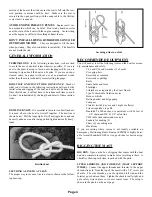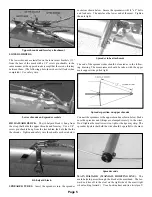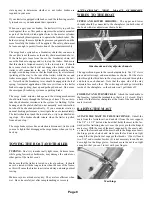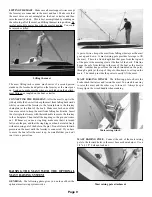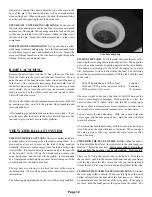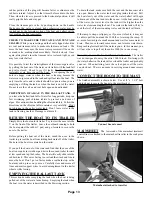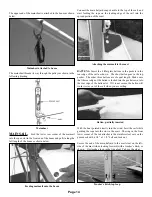
Page 1
OWNER’S INSTRUCTIONS MACGREGOR 26 M
PAGE
1
SPECIAL SAFETY WARNINGS
4
GENERAL INFORMATION
4
RECOMMENDED EQUIPMENT
4
RIGGING THE MAST
6
PREPARING FOR TRAILERING
7
PREPARING THE TRAILER
8
TOWING THE BOAT AND TRAILER
8
ATTACHING THE MAST SUPPORT WIRES
8
RAISING THE MAST
9
OPTIONAL MAST RAISING SYSTEM
11
ADJUSTING THE MAST SUPPORT WIRES
12
RAMP LAUNCHING
12
THE WATER BALLAST SYSTEM
13
RETURNING THE BOAT TO ITS TRAILER
13
EMPTYING THE BALLAST TANK
13
CONNECT THE BOOM TO THE MAST
13
MAINSHEET
PAGE
14
MAINSAIL
15
JIB (FORWARD SAIL)
16
GENOA (OPTION)
16
REDUCING THE AREA OF THE MAINSAIL
16
DAGGERBOARD
16
RUDDERS
17
HATCHES
17
BOOM VANG
18
SELF-RIGHTING CAPABILITY
18
FOAM FLOTATION
18
POWERING
19
BOAT MAINTENANCE
20
WIRING DIAGRAM
20
TRAILER MAINTENANCE
20
LIMITED WARRANTY
22
HOW TO SAIL
27 SAFETY DECALS
SPECIAL SAFETY WARNINGS:
Boats, like any other form of transportation, have inherent
risks. Attentions to these warnings and instructions should
help keep these risks to a minimum.
THE WATER BALLAST TANK SHOULD BE FULL
WHEN EITHER POWERING OR SAILING.
IF THE BALLAST TANK IS NOT COMPLETELY FULL,
THE BOAT IS NOT SELF RIGHTING. (IF YOU CHOOSE
TO OPERATE THE BOAT WITH AN EMPTY TANK, SEE
THE SECTION ON OPERATING THE BOAT WITHOUT
WATER BALLAST.)
WHEN THE BALLAST TANK IS FULL:
- NO MORE THAN 6 PERSONS, 960 POUNDS.
WHEN THE BALLAST TANK IS EMPTY:
- NO MORE THAN 4 PERSON, OR 640 POUNDS.
- CREW WEIGHT CENTERED FROM SIDE TO SIDE.
- ALL SAILS REMOVED, ENGINE POWER ONLY.
- NO ONE ON THE CABIN TOP OR FORDECK.
- WAVES LESS THAN 1 FOOT.
-OPERATE WHERE WATER IS WARM AND
RESCUE IS LIKELY.
- NEVER OPERATE THE BOAT WITH A PARTIALLY
FILLED TANK.
WHEN POWERING OVER 6 MILES PER HOUR:
- RUDDERS AND DAGGERBOARD FULL UP.
- SAILS REMOVED.
- NO ONE ON THE CABIN TOP OR FOREDECK.
ALWAYS, BEFORE OPERATING
THE BOAT,
CHECK TO CONFIRM THAT THE BALLAST TANK
IS FULL. THE WATER LEVEL IN THE BALLAST
TANK SHOULD BE NO MORE THAN 1” BELOW
THE LEVEL OF THE FORWARD VENT HOLE.
THEN MAKE SURE THAT THE FORWARD VENT
PLUG AND THE TRANSOM VALVE ARE CLOSED
AND SECURE.
THE FOLLOWING COMMENTS EXPLAIN WHY
THE ABOVE RULES ARE NECESSARY.
STABILITY.
Unless the water ballast tank is completely full, with 1000 pounds
of water ballast, the sailboat is not self-righting. Without the
water ballast, the boat may
not
return to an upright position if the
boat is tipped more than 60 degrees, and can capsize like most
non-ballasted sailboats.
The MacGregor is big, but relatively light, and excessive crew
weight can overpower the basic stability of the boat. For this rea-
son, we have placed the restrictions on crew capacity, shown in
the preceeding section.
OPERATING WITHOUT WATER BALLAST.
There may be times when you wish to operate the boat with an
empty ballast tank. For example, when pulling a water skier,
when trying to conserve fuel, when a faster ride is desired, or
when you are in the process of filling the tank. Since only a few
miles per hour are lost with a full tank, we recommend that most
of your use of the boat be with a full tank.
If the tank is empty,
carry no more than 4 persons, or 640 pounds.
When operating with an empty ballast tank, keep the crew weight
aft, low in the boat, and centered from side to side. Keep the crew
in the cockpit, sitting down. The rear of the hull is relatively flat,
and the nose area has a deep V to allow the boat to slide through
waves with less slamming. If there is a lot of crew weight for-
ward, the flat part of the hull bottom, which normally provides the
stability, is raised higher out of the water, and is less effective in
JULY 17, 2007
Summary of Contents for 26 M
Page 28: ...Page 28...




